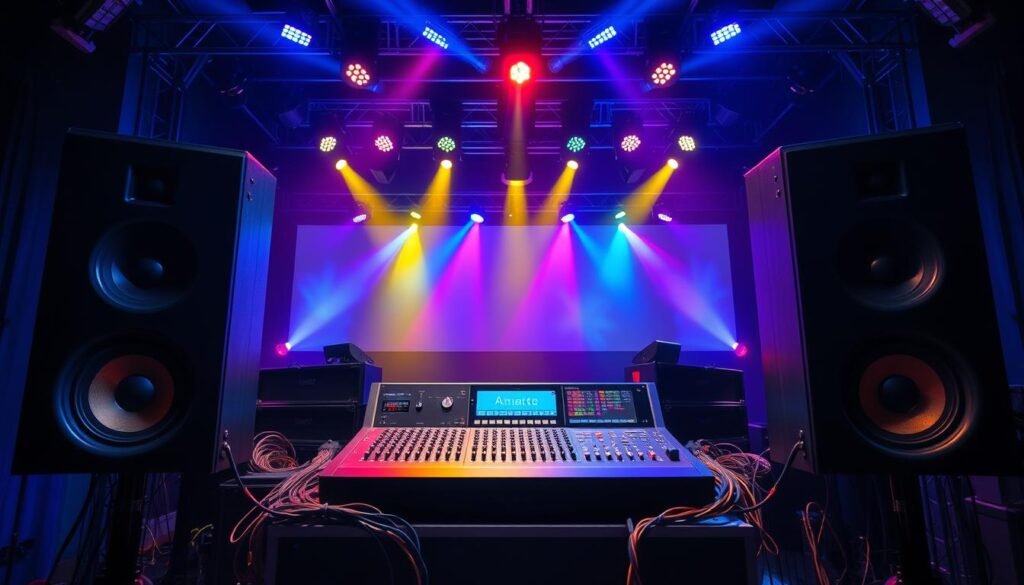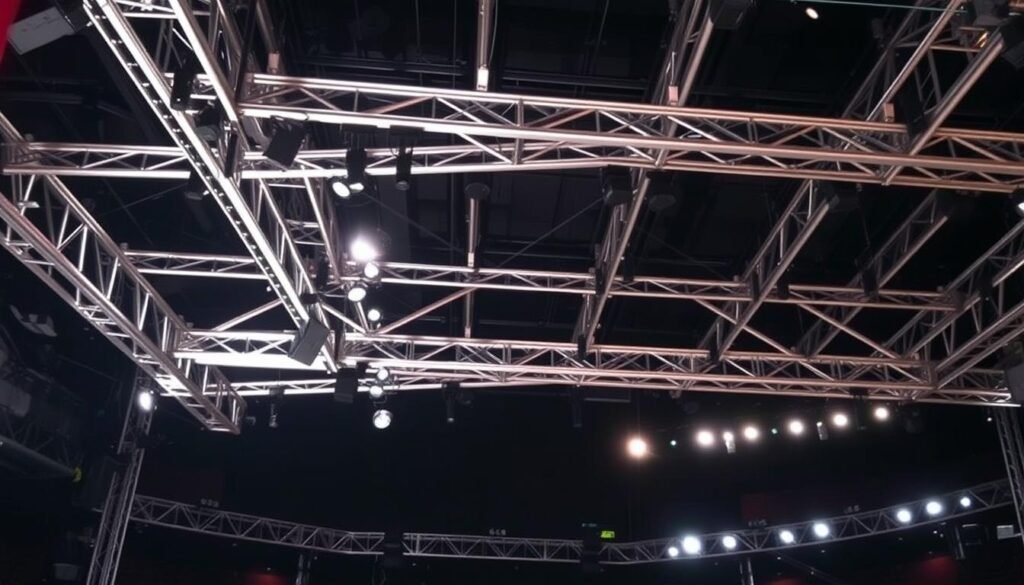ציוד הבמה הנכון הוא חיוני ליצירת הופעות מדהימות בתיאטרונים ובאולמות הופעות. ציוד באיכות גבוהה מבטיח אמינות, בטיחות וחוויות בלתי נשכחות לקהל. הקמת מערכת מתוכננת היטב עם טכנולוגיה מודרנית יכולה להביא את חזונות האמנות לחיים.
מומחים בארועים יודעים כי השקעה בציוד מעולה היא קריטית. זה משפר את ההשפעה הכללית של ההופעה. המערכת הזו יכולה באמת להפוך הופעה לזוהת.
הבנת רכיבי ציוד הבמה המרכזיים חיונית לתכנני אירועים ולמבצעים. תאורה, מערכות צליל, תלייה, ואפקטים חזותיים משמשים כלם תפקידים חיוניים. הם עובדים ביחד כדי ליצור הופעות חלקות ומעוררות התעניינות.
הבנת הרכיבים הללו עוזרת למקצוענים לקבל החלטות חכמות. הם יכולים לבחור ולהקים ציוד בצורה יעילה. הידע הזה מוביל לאירועים מוצלחים ולזיכרונות בלתי נשכחים.
מסקנות מרכזיות
- ציוד הבמה הוא חיוני ליצירת הופעות מרתקות במגוון מקומות
- השקעה בציוד באיכות גבוהה
ציוד ביצועים מבטיח אמינות, בטיחות וחוויות בלתי נשכחות
- הכנת תכנית טובה ל-הקמת במה המשלבת טכנולוגיית תיאטרון משפרת את ההשפעה של ההופעה
- הבנת הרכיבים העיקריים של ציוד במה חיונית ליועצי אירועים, מנהלי במות ומבצעים
- היכרות עם תאורה, צליל, תילות ואפקטים חזותיים עוזרת למקצוענים לקבל החלטות מושכלות בעת בחירה והקמת ציוד במה
ציוד תאורה חיוני להארת הבמה
תאורת במה יוצרת אווירה ומובילה את תשומת לב הקהל. היא מדגישה את המבצעים ומשפרת את החוויה הכוללת. מעצבי תאורה משתמשים במגוון פיסות, מערכות בקרה ואביזרים כדי ליצור הופעות מרהיבות חזותית.
סוגי פיסות תאורה לבמה
כמה סוגי פיסות תאורה משמשות ב-תאורת במה. כל אחת משרתת מטרה ספציפית.
- פנסי תאורה: פיסות אלה מייצרות קרן אור צרה ואינטנסיבית, אידיאליות להדגשת מבצעים פרטניים או אזורים ספציפיים בבמה.
- פנסי סטרובוס: פנסי סטרובוס מספקים תאורה רחבה ואחידה, מושלמת להארת אזורים גדולים או ליצירת אווירה כללית.
- פנסי רפלקטור אליפסואידלי (ERS): מערכות ERS מציעות שליטה מדויקת על זרימת האור ואפשרות להקרין דפוסים או מרקמים באמצעות גובוס.
- פנסי PAR: מערכות פנס קומפקטיות וגמישות אלו נהגות לשמש לתאורה כללית או ליצירת רחצות צבעוניים.
- מערכות תאורה בעלות דיוק גבוה: מערכות תאורה בעלות דיוק גבוה הן יעילות מבחינת אנרגיה, ארוכות טווח ומציעות מגוון רחב של אפשרויות צבע, ולכן הן מתפשטות בתחום התאורה בבמה.
מערכות שליטה וקונסולות תאורה
מערכות שליטה בתאורה ניהלות ומאפשרות אוטומציה של מגוון מערכות תאורה. הן מאפשרות למעצבים ליצור סצנות מורכבות ולהתאים את רמות הבהירות. מערכות אלו גם משנות צבעים ושולטות בזמנים של פקודות תאורה.
- קונסולות DMX: קונסולות אלו משתמשות בפרוטוקול DMX512 כדי לתקשר עם ולשלוט במערכות תאורה, מאפשרות שליטה מדויקת במאפייני כל פנס.
- בקרי תאורה ממוחשבים: מערכות אלה מבוססות תוכנה ומציעות תכונות מתקדמות, כגון ויזואליזציה ב-3D, סנכרון קוד זמן, ויכולת ליצור רצפי תאורה מורכבים.
- בקרי תאורה אדריכלית: מיועדים להתקנות קבועות, בקרים אלה משמשים לניהול תאורה בתיאטרונים, אולמות קונצרטים, ומקומות הופעות אחרים.
אביזרי תאורה ואפקטים
אביזרים ואפקטים שונים משפרים את ההשפעה הוויזואלית של תאורת הבמה. כלים אלה מוסיפים עומק ויצירתיות להופעות.
- צבעי ג'ל: גיליונות דקים ושקופים המונחים מול מכשירי תאורה כדי לשנות את צבע פלט האור.
- גובוס: תבניות מתכת או זכוכית המונחות בנתיב האור כדי להקרין דפוסים, מרקמים, או צורות על הבמה.
- דלתות אהל: פסים נתמכים המחוברים למכשירי תאורה, המשמשים לשליטה בצורה ובכיוון של קרן האור.
- מכונות ערפל וערפל: מכשירים אלה יוצרים אפקטים אטמוספריים שמשפרים את נראות קרני האור ומוסיפים עומק לבמה.
- תאורת סטרובוס: תאורה מהבהבת שיוצרת אפקט פולסטי, נהוגה לשימוש בהופעות בעלות אנרגיה גבוהה או לחידוש הרעם.
מעצבי תאורה משתמשים בכלים אלה כדי ליצור אפקטים חזותיים מרהיבים. בחירות התאורה הנכונות מעבירות את הקהל לעולמות שונים. הן מעוררות רגשות עוצמתיים והופכות הופעות לא נשכחות באמת.
מערכות קול: מספקות אודיו באיכות גבוהה
מערכת קול מעולה היא חיונית לביצועים ברורים וללא אי פשרות. חלקים מרכזיים כוללים מיקרופונים, ערבלים, מגברים ורמקולים. כל רכיב הוא חיוני לאיכות צליל מעולה.

בחירת ה-מיקרופונים הנכונים חיונית ללכידת שמע ברור ומדויק. מיקרופונים אלחוטיים מציעים גמישות לשחקנים וזמרים. מיקרופונים לכלי נגינה מיועדים ללכידת תכונות טונאליות ייחודיות של כלי נגינה שונים.
מיקרופונים באיכות גבוהה מבטיחים ללכוד שמע מקורי בדיוק ובבהירות. השקעה זו משתלמת באיכות צליל יוצאת דופן להופעות.
מערכת צליל מעולה היא היסוד של כל הופעה חיה שמתוארת. היא מביאה לחיים את חזון האמן ויוצרת חוויית צליל סוחפת לקהל.
מהנדסי צליל משתמשים בקונסולות מיקסור כדי לאזן רמות שמע ולהחיל אפקטים. כלים אלה עוזרים ליצירת מיקסים צליליים מקצועיים ומאוזנים. תכונות מתקדמות כמו EQs ואפקטים מרחיבות את האפשרויות היצירתיות.
מערכות PA מפיצות צליל לקהל באמצעות מגברים ורמקולים. המערכת הנכונה תלויה בגודל האולם וסוג האירוע. מערכות שורת קווים עובדות טוב בהופעות גדולות.
אולמות קטנים עשויים להעדיף רמקולים קומפקטיים מקור-נקודה. הגדרה תקינה מבטיחה כיסוי שמע אחיד ומפחיתה משובים ואי סטיות.
| רכיב | מטרה |
|---|---|
| מיקרופונים | ללכוד מקורות צליל באופן מדויק |
| שולחן מיקסור | לאיזון, עיבוד והפנית סיגנלי קול |
| מגברים | להגברת סיגנלי קול להוביל רמקולים |
| רמקולים | להפקת צליל לקהל |
ציוד צליל מקצועי ומהנדסי צליל מיומנים הם חיוניים לחוויות שמע מדהימות. בחירה והגדרה זהירה של כל חלק במערכת מבטיחה ביצועים ברורים ומשפיעים.
הדגש על פרטים זה מסייע ליצירת קשרים רגשיים עם הקהל. זהו המפתח למסירת אירועים חיים שלא נשכחים.
ציוד במה: תלייה, תשתית ומבני תמיכה
תליית במה ומערכות תשתית הן חיוניות לתליית תאורה, ציוד צליל וציורים. מבנים אלה מהווים את הגב התשתיותי של הקמת במות. הם מבטיחים שכל הרכיבים מאובטחים וניתנים לניהול בקלות.
מבני נשיאת משקל הם חיוניים ליצירת ביצועים מרהיבים. הם מספקים בטיחות ויעילות בהפקות במה.
מערכות תלייה ורכיבים
תליית במה משלבת רשת מורכבת של רכיבים. אלה עובדים ביחד כדי לתלות ולתמוך בציוד שונה בבטחה.
הרכיבים המרכזיים במערכת תלייה כוללים:
- חבלי חוט: כבלים חזקים וגמישים שנושאים את משקל הציוד שתלוי
- מנעולים: מחברים בצורת U המחברים חבלי חוט, שרשראות או רכיבי ריגינג אחרים
- בקרות: מכשירים עם גלגלים שמאפשרים לחבלים או כבלים לשנות כיוון ולתמוך במשקלים כבדים
- מעליות: מכשירים מכאניים המשמשים להרמה והורדת ציוד, לעיתים קרובות מומצאים לשליטה מדויקת
רכיבים אחרים כמו רצועות, ברגי עין ופיתוחים הם חשובים גם. הם מהווים את היסוד של מערכת ריגינג לבמה אמינה.
מערכות טראס ומבני תמיכה

מערכות טראס ומבני תמיכה מספקים את המסגרת להרכבת ציוד בבמה. רובם עשויים מאלומיניום או פלדה. חומרים אלה מציעים יחס כוח-משקל מעולה.
מבני טראס ניתן להגדיר בצורות וגדלים שונים. הגמישות הזו מאפשרת עיצובים יצירתיים לבמה.
הגדרות רשימה נפוצות כוללות:
| סוג הקש | תיאור | יישומים |
|---|---|---|
| קש תיבה | חותך מרובע או מרובע, מציע קשיחות גבוהה | אידיאלי לתמיכה במשקעים כבדים ויצירת מבנים גדולים ויציבים |
| קש משולש | חותך משולש, מספק כוח ויציבות מעולים | נהוג לשימוש במערכות גג ותמיכה בגשרים גדולים |
| קש סולם | עיצוב קל משקל ופתוח, דומה לסולם | נפוץ לשימוש בבמות קטנות ותמיכה בציוד קל משקל |
בחירת מערכת הטראס הנכונה חיונית. זה עוזר ליצור מבני תמיכה בטוחים, יעילים ומרשימים חזותית.
הטראס המתאימה יכולה לשפר מאוד את חוויית הביצועים בכלל.
שיקולים בטיחותיים לריגינג וטראסינג
הבטיחות היא עיקרית בריגינג בבמה ובמערכות טראס. מבנים אלה תומכים בציוד כבד ומבטיחים את בטיחותם של הבמאים והצוות.
הצעדים לבטיחות העיקריים כוללים:
- הצפה בתקני בטיחות תעשייתיים ושיטות מובילות
- ביצוע בדיקות תקופתיות ותחזוקה של כל רכיבי הריגינג והטראס
- הבטיחות שרק מקצוענים מאומנים ומוסמכים יעסקו בהתקנה והפעלה של מערכות אלה
"הבטיחות היא לא רק עדיפות; זו כובדת חובה כאשר מתעסקים בריגינג בבמה וטראסינג. אין מקום להפשרות כאשר מדובר בבריאותם של כל מי שמעורב בהפקה."
– ג'ניפר תומפסון, בודקת ריגינג מוסמכת
ציוד תלייה וצירוף איכותי ומתוחזק הוא חיוני. זה מאפשר חוויות חזותיות מרהיבות תוך הפחתת הסיכונים.
התמקדות בבטיחות עוזרת למנוע תאונות וכשלי ציוד. הגישה הזו מבטיחה הפקות במה מוצלחות ובטוחות.
אפקטים חזותיים וטכנולוגיית ההקרנה
אפקטים חזותיים וטכנולוגיית ההקרנה יוצרים הופעות בבמה מרתקות. הם מעבירים את הקהל לעולמות שונים ומשפרים את סיפור העלילה. הקרנת וידאו, מסכי LED, ואפקטים מיוחדים מעלים את ההשפעה החזותית של ההפקות.
מערכות הקרנת וידאו
מקרנים ושרתי מדיה מציגים תוכן דינמי על משטחים שונים. מיפוי הקרנה משנה את הבמות, הסטים, והמבצעים לקנבסים אינטראקטיביים. טכניקה זו יוצרת אפקטים חזותיים מרהיבים שמתמזגים באופן חלק עם ההופעות.
מסכי LED ומסכים
מסכי LED מציעים פתרונות ברזולוציה גבוהה להצגת וידאו וגרפיקה. הם יוצרים רקעים דינמיים שמשתנים לאורך ההופעות. מסכים אלה יכולים להציג מידע בזמן אמת, משפרים את ההשתתפות של הקהל.
ציוד ליצירת אפקטים מיוחדים
מכונות עשן, מפיצי עשן, ופירוטכניקה מוסיפים תחושת מרץ לבמה. האפקטים הללו מתיחברים עם תאורה, וידאו, וצליל כדי ליצור רגעים חזקים. תכנון זהיר מבטיח בטיחות למבצעים, לצוות ולצופים.



